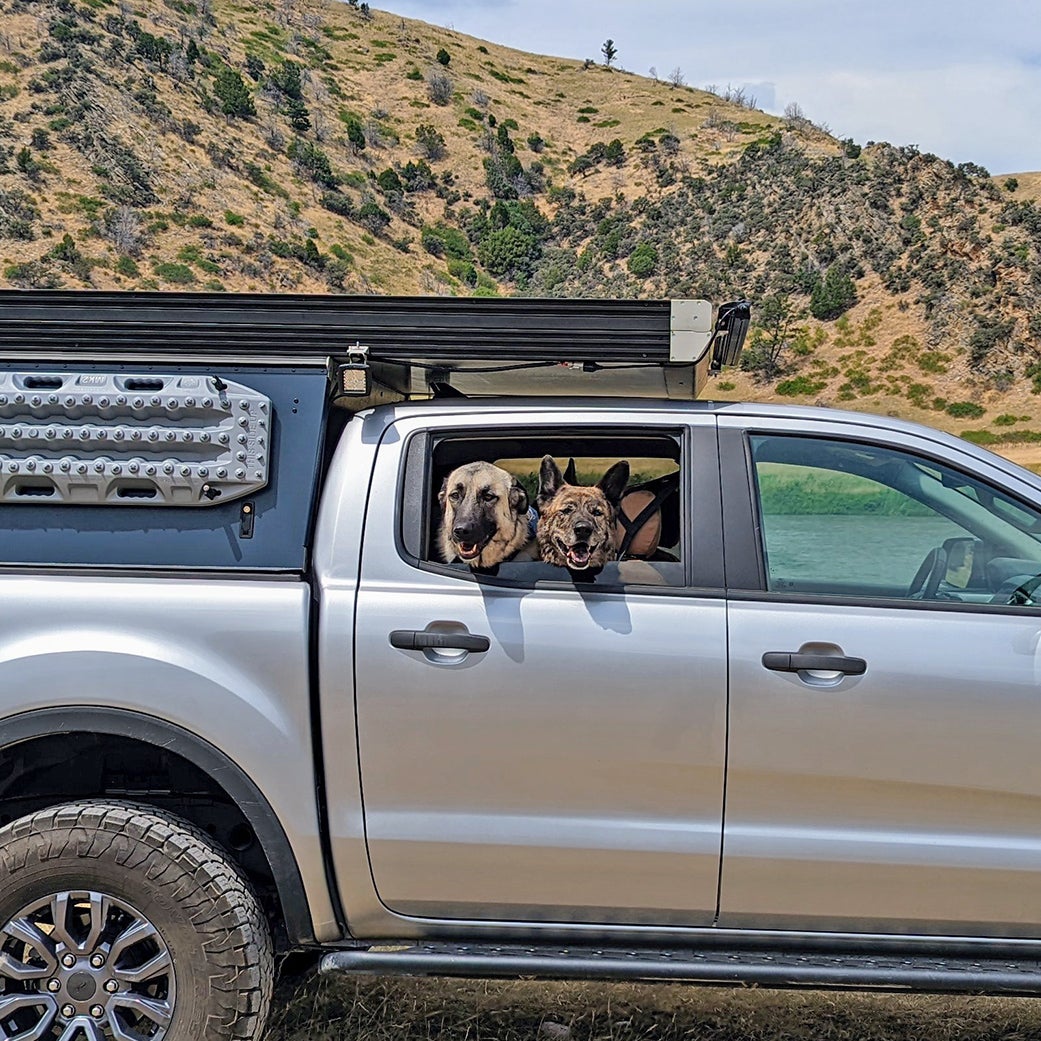How do you carry dogs in your pickup truck? There are a lot of wrong answers, and no totally optimal ones. Factors like safety—for both the dogs and humans—are difficult to address entirely, especially when you also need to protect the dogs from hot temperatures and extreme weather, and give them a comfortable place to relax on long drives. It wasn’t easy, it wasn’t cheap, and it involved turning my five-seat truck into a two-seater, but I think I finally found a solution that works for my pack.��
The Problem
As I wrote about when I described the fancy dog barrier I installed in my wife’s SUV, or when I delved into car safety restraints for dogs, and when I looked at safety-rated dog crates, our vehicles are designed for humans, not animals. That makes it challenging to ensure everyone on board stays safe.��
One of the largest issues is seat strength. Many popular dog barriers rely on friction with the ceiling and floor of the car to hold themselves in place, or simply hang from the headrests, leaving only the seats standing between you and a dog-turned-projectile if you’re involved in a crash.
Those seats are also designed for bipeds who fold conveniently in the middle, and like to sit upright. Quadrupeds don’t contort into the same shapes we do, so any seats you try to load them into just waste space.��
Why not just carry your dogs in the bed of the pickup? Well, in the U.S. riding in uncapped beds. I have a on mine, so it’s capable of keeping the dogs from falling out, but it does nothing to limit their movement inside the enclosed space. And there’s enough room in even small truck beds for dogs to experience what’s called a third-space impact. That’s where you crash your car, and your dog accelerates forward into the back of the cab, resulting in severe injury or death. To truly keep a dog safe in a moving vehicle, you need to contain it inside a space small enough that it won’t fly forwards in a crash.��
Plus, truck beds get very hot and very cold, depending on the weather. The safest place for your dog��is inside the back seat of your truck. But only if they’re securely contained in that back seat, and only if you can comfortably fit all of them back there.��
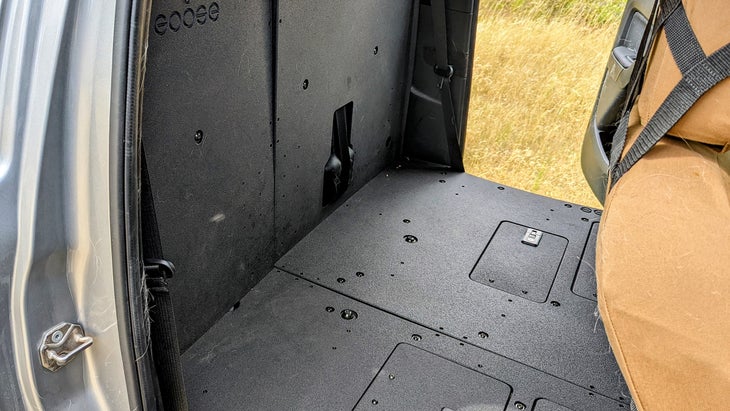
First, Add Space
I drive a mid-size pickup—. The relatively small proportions of trucks like mine are more capable and easier to drive off-road, with the obvious compromise being less space inside. While I was able to jam my entire 300-pound collection of dogs into the back seat, they couldn’t get comfortable. The result? A lot of whining and the occasional dog fight.��
In addition to a restraint, I needed to find a way to maximize space. So I pulled out the back seat.��
Pulling a set out of a vehicle doesn’t typically result in a clean, flat load surface. Instead, there are usually voids, fragile parts, exposed hardware, and other stuff that may cause problems when filled with dogs. But a company in California called specializes in plate systems that bolt in place of your seats, creating that ideal flat, square surface, while maximizing space. They’re designed for cargo, not dogs, but are plenty strong, and with a little creativity, can easily be adapted to canine use.��
Removing the rear seat was pretty easy. The only speciality tool required was a T50 Torx bit for two of the seatbelt mounts. Installing the plate system was also straightforward, once’d I’d navigated Goose Gear’s lack of instructions, and convinced them to ship me all the correct parts.��
With a background in custom home cabinetry, Goose Gear makes its plates from half-inch-thick that’s substantially lighter and much more resistant to moisture than typical plywoods. That wood is then coated in a spray-on bedliner material that’s virtually impervious to scratches and dents. Slotted aluminum tracks hold everything together. They’re CNC-machined in-house and connected to the vehicle using the bolt holes left behind when you remove the seats. Each system is custom designed and built for each individual vehicle model.��
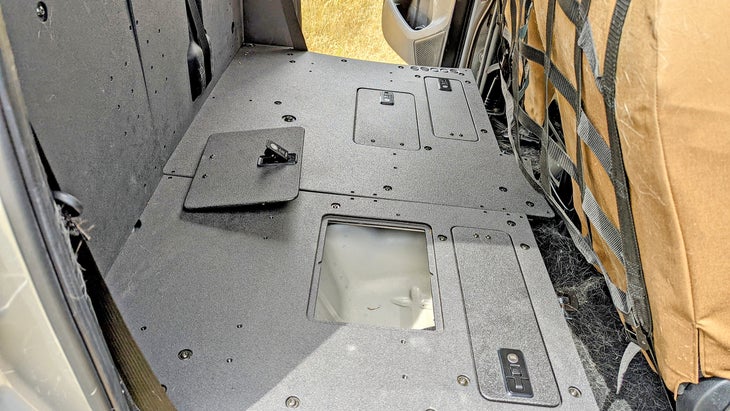
As you might guess, designing a flat, square load area to fit over the voids and contortions in the back of every unique vehicle the company builds products for is complicated, and can involve some compromises. Goose prototyped the Ranger system in the back of a Lariat-trim vehicle, which includes a large subwoofer behind the rear seat. My XLT doesn’t have that sub, so I had to build a replica out of styrofoam and glue, to give one of the vertical plates the appropriate level of support.��
Once I’d navigated those hurdles, the end result was seriously nice. Bolted to the same frame mounts used to restrain human occupants in a crash, and supported by hardware on all sides, the Goose Gear plate system is easily now the strongest, highest quality component inside my Ranger’s cab.��
Nothing rattles, squeaks, comes loose, or creates any awkward gaps. Four lockable lids in the floor plates create secure storage areas underneath the system, both in the Ranger’s under-seat voids, and in the newly boxed-in footwells. I’ll be able to use those to transfer some infrequently used tools and recovery gear out of the Decked drawers in my bed, freeing up space back there.��
At , you pay for that quality, but even with professional experience in carpentry, there’s no way I could have matched the slick, stout execution Goose Gear achieved, even if I had access to equivalent tools.��
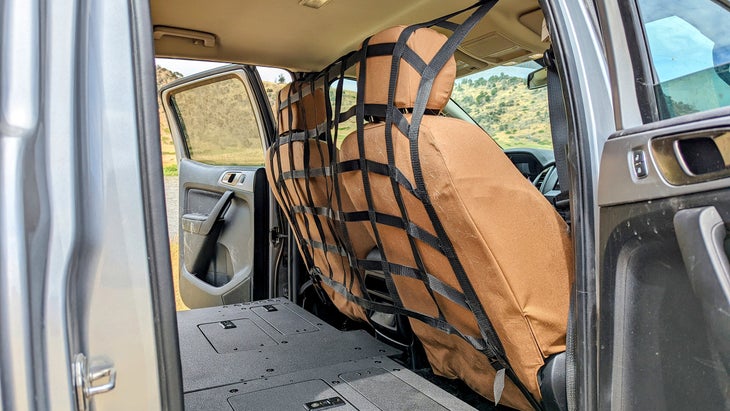
What About Safety?
When I modified my wife’s SUV, I discovered how inadequate friction-fit barriers are. My solution there was a steel cargo barrier that bolted to her vehicle’s frame. Is there anything similar that fits inside a pickup cab? Yes and no.��
Inside the relatively tight confines of a passenger cab, which must include big holes on the sides for doors, there are few places available to connect with the actual frame. The most accessible, strongest locations are where the seatbelts connect, on the B-pillars. The trouble is, most front seats protrude rearwards, past the B-pillars and their seat belt mounts. So there’s not room for a straightforward metal cargo barrier.��
Enter . They bolt to the correct places and are capable of withstanding 800 to 2,500 pounds per square-inch of pressure, enough to restrain dogs of any size in a crash. As a recap, a 60-pound dog generates 2,700 pounds of force in a 35 MPH crash. As long as that 60-pound dog is larger than three square inches, the net should hold. , the Raingler costs $220.��
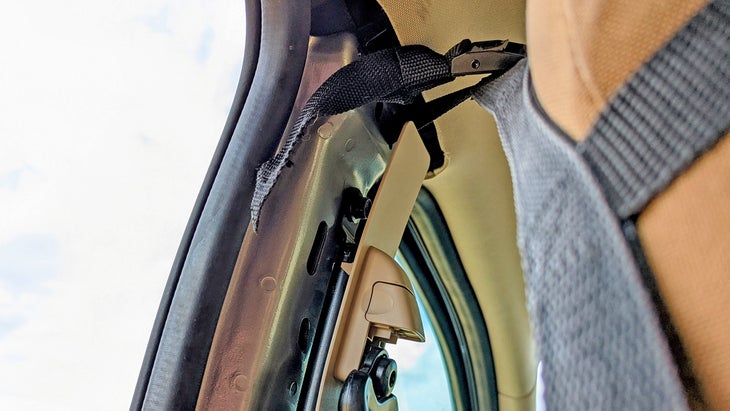
There are two problems: your vehicle’s plastic trim and the position of the seats. Raingler, which actually includes instructions with its products, suggests that you remove the plastic B-pillar trim, then drill holes into your steel frame from which you can hang a mounting tab for the net. The Ranger’s trim interferes with that mounting tab, so I just pulled the trim out entirely, and passed the net through pre-existing holes in the steel. The result is an ugly, if effective solution.��
The seat position is a bigger issue. If you’re tall enough that you locate the rear of your seat further back than the B-pillar, as I must in most vehicles thanks to my 34-inch inseam, the net will be stretched rearwards, and won’t fully restrain dog-turned-projectiles until they have at least partially crushed the seat forwards.��
So, I’m compromising everyone’s safety, but at least achieving what will presumably be some, while keeping the dogs in their own area while driving. That’s a major improvement, if still not a total solution.
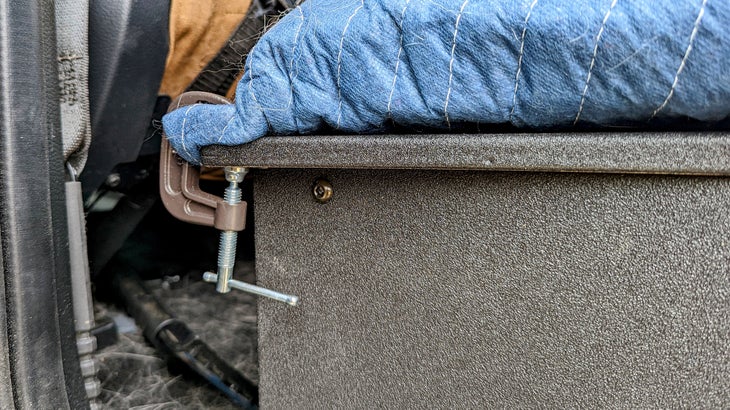
What About Comfort?
The plate system added about eight inches of total length to what was the rear seat area, while creating a totally flat floor. That’s enough room for all of my large dogs to comfortably lay down. But no one’s going to be comfortable trying to recline on bed-liner coated plywood.��
Acting on a tip from Kelly Lund, who owns the Insta-famous malamute-mix , I cut a two-inch memory foam mattress topper to match the dimensions of the plate system, wrapped it in a Harbor Freight moving blanket, and secured it all to the plate floor with one-inch C-clamps. I’ve found those moving blankets almost comically good at handling all the fur and liquids expelled by dogs, and at $12, they’re cheap enough that you can just replace them when the fur and liquids inevitably win the battle.��
Because my dogs can all comfortably fit back there, in a safely confined space, this setup also gives them a place to sleep on camping trips.
I should also mention that I specifically optioned a truck with remote start, to give my dogs a comfortable, safe place to hang out when I need to run into a store. Using Ford’s smartphone app, I’m able to keep the car running, with the air-conditioning on, for an indefinite length of time.
Last weekend, I drove 600 miles with all three dogs onboard. Rather than complain and cause a ruckus the entire time, as they always had before, they all just laid down, went to sleep, and generally behaved themselves. If nothing else, the lack of distraction was a roaring success, both for my ability to drive safely and my sanity. Sure, it cost $2,500, and means I’ll never use my backseat for humans again, but knowing my dogs can now travel with me in safety and comfort is priceless.


